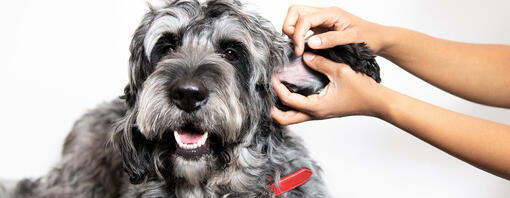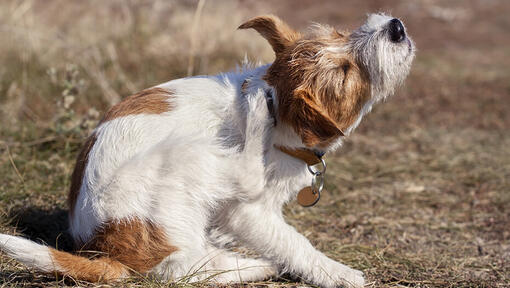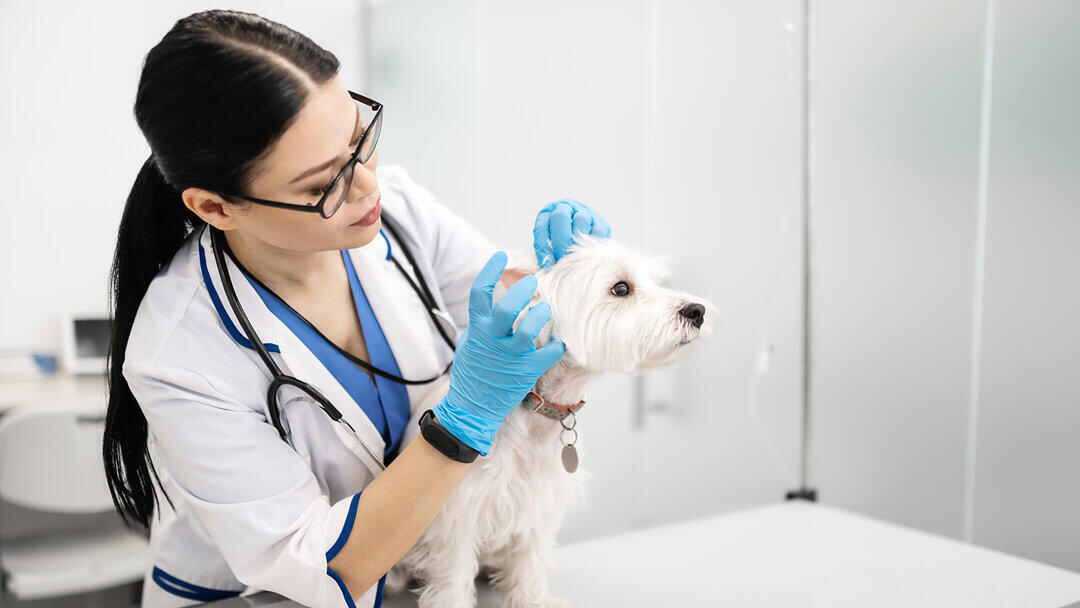
Discovering mites on your dog can be concerning. These parasites cause discomfort, leading to itching, scratching, and in some cases, hair loss. This guide provides information on dog mite types, prevention, and treatment options to help you keep your dog mite-free.
What are dog mites?
Mites are tiny parasites, usually under a millimetre long, that may live in the fur, the ears, or burrow into your dog’s skin, causing irritation and inflammation. Mites are a fairly common health concern for dogs. There are a number of different types of mites, and they can cause a range of skin conditions, from dry skin to hair loss, skin irritation and intense itchiness, if left untreated.
Mites are also what cause ‘mange’, a well-known skin condition in dogs.
What health conditions do dog mites cause?
If your pet is infested with dog mites, it is known as a condition called mange. The common types are 'sarcoptic mange' and 'demodectic mange'. Other conditions caused by mites include cheyletiellosis, and trombiculosis, also known as 'harvest mite' infestation. Ear mites live in the ear canals of dogs and can cause severe discomfort, so spotting and treating ear mites is extremely important.
What are the types of dog mites?
There are different types of mites which can affect your four-legged friends.
- Demodectic Mites (Demodex)
These mites live within the hair follicle of your dog’s skin and are not often spread between dogs or humans. The main way that this type of dog mite is transferred is during early puppyhood, when female dogs nurse their pups. While a small number of these mites are considered normal skin inhabitants, an overgrowth can lead to Demodectic mange, a skin condition which causes your dog’s fur to fall out in patches, requiring attention from your vet. - Sarcoptic Mites (Sarcoptes)
This type of mange is caused by a contagious mite which spends its life cycle buried in the outer layer of your dog’s skin. It causes your dog to become itchy which can lead to skin inflammation, or painful wounds which are a product of scratching. These mites can easily be passed between dogs, as well as between dogs and humans. Sarcoptic mange is sometimes termed ‘scabies’. - Ear mites
Ear mites in dogs are quite a common mite that many owners will be familiar with. They aren’t burrowing mites, which means they may be visible as very tiny white dots. These are tricky to see with the naked eye, but your vet may be able to spot them when they look in your dog’s ear with an auroscope. These types of mites will present themselves similarly to an ear infection. - Harvest mites
Usually found on the feet and legs, harvest mites are commonly picked up by dogs in rural areas. These mites can also affect cats as well as humans, and are more often seen in the late summer months. - Cheyletiellosis
This type of dog mite is known as ‘walking dandruff’ because initially it looks like your pet just has dandruff. It’s not usually itchy unless your pet has a hypersensitivity to the mite, and can spread between dogs and other animals.
What Do Dog Mites Look like?
Dog mites are incredibly small, so there are few chances that you’ll be able to see them with the naked eye. However, on rare occasions, you might spot them as tiny moving specks in colours like orange, black, or white on your dog’s skin, fur or ears.
Sarcoptic mites are tiny, round creatures, measuring about 0.2 to 0.4 millimetres. In contrast, Demodex mites are more elongated, with a size ranging between 0.3 and 0.4 millimetres.
Harvest Mites are usually 0.4 millimetres and have a characteristic bright orange colour. Even smaller still are ear mites, which are roughly 0.1 to 0.3 millimetres in length. These mites, which are spider-like in appearance, typically require a microscope to be seen clearly.
How do dogs get mites?
Dogs can pick up mites from a number of places. They are often passed from dog to dog, but they can come from their environment too. The precise ‘how’ they are transmitted depends on the type of mite.
Your dog may catch mites if they come into contact with another dog who has them. Typically this will be another dog in the household, but can also be in places such as an animal shelter or grooming establishment. Your dog may also pick them up from another dog when you’re out and about on a walk.
Dog mites may also continue to live in the environment, such as in their bed or in the carpet, after they or another dog have been contaminated. Your dog can then pick them up again, which is why you should make sure everything is clean and mite-free after a known infestation.
How do I tell if my dog has mites?
Sarcoptic mange is a very itchy and unpleasant dog skin condition that can also affect humans. Affected dogs can cause damage to their skin and coat with constant scratching, leaving redness and sometimes scabs.
Demodectic mange is a serious skin complaint that causes hair loss, reddening, sore areas, scaling, crusting, lesions and the darkening of chronically affected skin. It usually affects younger dogs and can be very serious if left untreated.
Dog mite symptoms
If you notice the following symptoms in your dog, they may have mites:
- Hair loss (either in patches, or all over their coat).
- Dandruff.
- Excessive scratching.
- Visible irritation, such as red skin.
- You may even be able to see mites on their skin – part the fur and look closely.
Diagnosing mites in dogs
You might get clues as to whether your dog has mites by carefully studying their skin. If they’re scratching, biting, or chewing themselves excessively you might suspect they have mites, and take a closer look.
Your vet, however, is the best person to diagnose mites in your dog. They will be able to tell what kind of mites your dog has, and how they should be treated.
Your vet will usually diagnose mites by studying a piece of skin or hair under the microscope. Taking samples is a quick and usually pain-free procedure. This will help your vet identify the type of mite affecting your dog.
Dog mites treatment
The good news is that most mite infestations can be effectively treated.
Your vet may prescribe medicine or a spot-on to help get rid of the infestation, or sometimes a wash or shampoo. Sometimes more than one dog mite treatment will be used at a time, and they may have to be administered for a while. The best thing you can do is be patient and persevere – and soon your dog will be mite-free!
How to prevent dog mites
The best way to prevent dog mites is to ensure they don’t come into contact with a dog who has them. This can be tricky, as you won’t always know, but keep an eye out if they come into contact with an unfamiliar dog.
If you dog has been treated for mites, wash their bedding and check that their surrounding environment has been cleaned, as this can help prevent re-infestation. And, of course, if your dog has mites make sure they don’t pass them on – usually by keeping them away from other dogs until they’ve been treated.
How long do mites live on dogs?
Dog mites can live in your dog’s skin for three to four weeks, and during this time, they’re quite busy. After mating, the female mite burrows into the skin to lay her eggs, typically three to four at a time. Within just three to ten days, these eggs hatch into larvae, which then make their way to the skin's surface. As they mature, they progress through a nymphal stage before becoming fully grown adult mites. These adults continue to roam on the skin's surface, mate, and restart the cycle as the females burrow once more to lay eggs. It's a relentless process that can cause a lot of discomfort for your dog, so spotting and treating mites early is essential.
Dog Mites and Humans - can a person get mites from a dog?
Mites typically only prefer one species; however, some can also infect humans if they come within close contact with the mite. The most common dog mites which can affect humans are sarcoptic dog mites, these are highly contagious and can cause itchiness and inflammation.
If you'd like to know more about preventing and treating skin conditions in dogs, check out our easy guide to dog skin problems. Or find out more about treating ticks, fleas and other parasites on dogs.


















